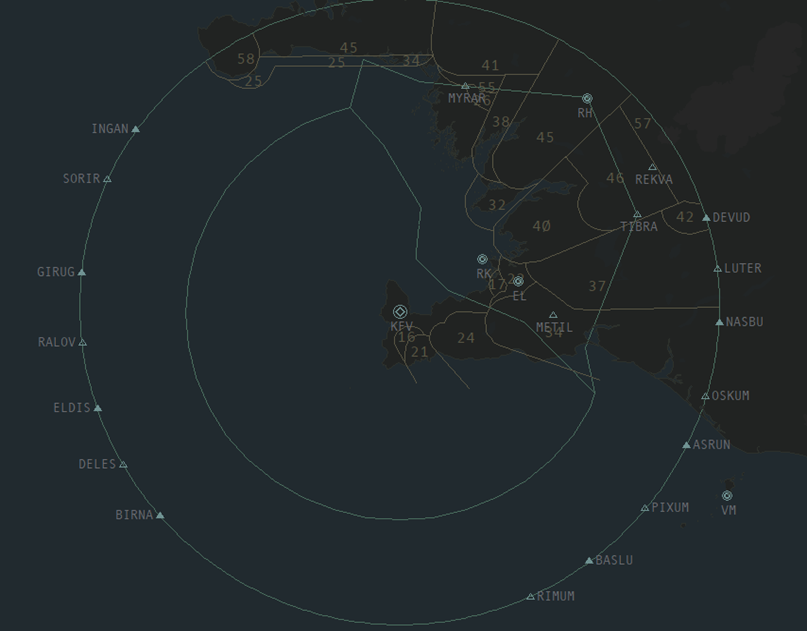General
The following page lists information and procedures applicable to the entire Faxi TMA, i.e., both Keflavik & Reykjavik Approach.
List of ATS Positions
|
Coordination Name |
VATSIM Logon |
Radio Callsign |
Frequency |
|
Keflavik Approach (KFA) |
BIKF_APP |
“Keflavik Approach” |
119.300 |
|
Reykjavik Approach (RKA) |
BIRK_APP |
“Reykjavik Approach” |
119.000 |
|
Keflavik Final (KFF) |
BIKF_F_APP |
“Keflavik Approach” |
119.150 |
Division of Responsibilities
The KF sector is controlled by Keflavik Approach, and the RK sector is controlled by Reykjavik Approach. If Reykjavik Approach is not online, Keflavik Approach bandboxes to cover Reykjavik Approach as well.
When both Keflavik & Reykjavik Approach are online, they operate as detailed in the "Dual Approach Operations" section below.
“Approach” or "APP" in this chapter, unless otherwise specified, refers to Keflavik Approach online by itself, bandboxing both sectors of the TMA and controlling arrivals and departures into both BIKF & BIRK.
Login Priority
Keflavik Approach may be opened at any time. Reykjavik Approach, and Keflavik Final, may only be opened with the approval of Keflavik Approach.
Overview of the Faxi TMA

The Faxi TMA (3000ft — FL245) is located above Keflavik (BIKF) and Reykjavik (BIRK) airports. It is divided into two sectors – the Keflavik (KF) sector above BIKF, and the Reykjavik (RK) sector above BIRK.
Collars

The Faxi TMA also has "collars" (formerly known as "buffer zones") surrounding the BIKF & BIRK CTRs (Control Zones.) These extend the TMA down to 1000ft or 2000ft MSL.
Airspace Classification
The Faxi TMA consists of Class A, Class C, and Class D airspace.
- The entire TMA is Class A above FL195.
- Below FL195:
- The KF sector is Class C.
- The RK sector is Class D.
The surrounding airspace is either Class A for the Oceanic Area directly above the TMA (FL245+), Class E for the Domestic Area surrounding the TMA (3000ft – FL245), or Class G for the airspace below 3000ft.
Minimum Horizontal Separation
The minimum horizontal separation in the Faxi TMA is 3 NM within 30 NM of KFV. This is a non-standard reduction of separation. Over 30 NM from KFV, the standard horizontal separation minima of 5 NM applies.
Delegated Airspace
60 NM Ring
Surrounding the TMA is a 60 NM ring from Keflavik, upon which the various starting/ending fixes for BIKF (and some of BIRK)’s SIDs & STARs lie. This circle is colloquially known as the “Faxi Coordination Circle.”

The airspace between the 60 NM ring & the Faxi TMA is delegated from Reykjavik Control to Keflavik/Reykjavik Approach. Arrivals passing the 60 NM boundary are transferred to Approach and are considered fully released.
Minimum Vectoring Altitudes
Minimum radar vectoring altitude areas have been established in the Faxi TMA. These are indicated by the golden lines & text on the image above. Levels are indicated as hundreds (e.g., 41 = 4100ft).
Approach may not issue vectors or directs to aircraft which will cause them to violate the MVA areas.
Internal Standing Agreements
60 NM Release for Arrivals
Reykjavik Control clears arrivals onto the STAR and descends the aircraft via STAR to FL100. Reykjavik transfers communications 60 NM from Keflavik (as noted in Chapter 3.3.1). Such arrivals are considered fully released.
Departures are transferred to Reykjavik Control at the TMA boundary (note: not at the 60 NM ring).
Dual Approach Operations
Keflavik Approach handles radio communications with all BIKF arrivals & departures throughout the entire TMA, regardless of whether the aircraft is presently in the KF or RK sector. Likewise, Reykjavik Approach handles radio communication with all BIRK arrivals & departures throughout the entire TMA.
All aircraft are released for climb (for departures) and descent (for arrivals.) Both Approach positions are responsible for coordinating appropriate releases for turn for aircraft located in the “opposite” sector of the TMA (i.e., KF sector for Keflavik Approach, or RK sector for Reykjavik Approach.)
